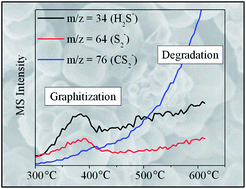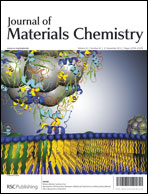A fundamental analytical and electrochemical study on various sulfur-poly(acrylonitrile) (SPAN) composites for Li–S batteries synthesized at various temperatures is presented. According to elemental analysis and X-ray photoelectron spectroscopy (XPS), the sulfur content in SPAN composites decreases with increasing synthesis temperature. However, as shown by RAMAN spectroscopy, higher synthesis temperatures result in higher degrees of graphitization of the polymer backbone and eventually in higher C-rate capabilities and higher cycle stability. The latter is also supported by the larger specific surface area of the SPAN composite prepared at higher temperature. However, complementary thermogravimetry-mass spectroscopy (TG-MS) measurements show a degradation of the composite prepared at temperatures >450 °C, rendering 390–460 °C the optimum temperature range for synthesis. Finally, the C-rate capability increases with decreasing thickness of the cathode, resulting in a 95% relative specific capacity at 1C compared to C/10.

You have access to this article
 Please wait while we load your content...
Something went wrong. Try again?
Please wait while we load your content...
Something went wrong. Try again?


 Please wait while we load your content...
Please wait while we load your content...